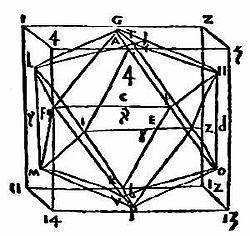- De Prospectiva Pingendi
-
De Prospectiva Pingendi (On the Perspective for Painting) is a Renaissance mathematical book about perspective in painting,[1] written by the Italian master Piero della Francesca. The scripture was written around 1480 [2] by Piero della Francesca, but was released in bookform first in 1899. Today the original copy is in the archives of the Biblioteca Ambrosiana in Milan.
Contents
The book
The subjects covered by Piero della Francesca in these writings include arithmetic, algebra, geometry and innovative work in both solid geometry and perspective.[3][4]
The script consists ot three parts:
- Part One Disegno, describing techniques for painting faces
- Part Two Commensurazio, describing perspectives
- Part Three Coloro, describing techniques for creating perspectives by using colours
History
De Prospectiva Pingendi was probably created in the years between 1474 until 1482.[1][2][4]
The writings were inspired by the book De pictura by Leon Battista Alberti [2] printed in 1435 [1] but probably also by works by Euclid.[4] The manuscript later came into the possession of the Biblioteca Palatina in Parma [4] before it was transferred to the Biblioteca Ambrosiana.
Much of Piero’s work was later absorbed into the writing of others, notably Luca Pacioli. Piero’s work on solid geometry appears in Pacioli’s "De divina proportione", a work illustrated by Leonardo da Vinci.
In 1899 the writings were first published in bookform.[5]
References
External links
Categories:- 1480s books
- History of mathematics
- History of geometry
- Art history
- Manuscripts
Wikimedia Foundation. 2010.


